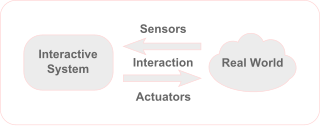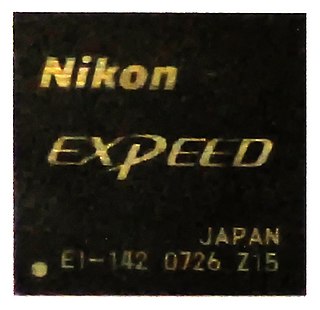Computer vision is an interdisciplinary scientific field that deals with how computers can gain high-level understanding from digital images or videos. From the perspective of engineering, it seeks to understand and automate tasks that the human visual system can do.

An embedded system is a computer system—a combination of a computer processor, computer memory, and input/output peripheral devices—that has a dedicated function within a larger mechanical or electrical system. It is embedded as part of a complete device often including electrical or electronic hardware and mechanical parts. Because an embedded system typically controls physical operations of the machine that it is embedded within, it often has real-time computing constraints. Embedded systems control many devices in common use today. Ninety-eight percent of all microprocessors manufactured are used in embedded systems.

Machine vision (MV) is the technology and methods used to provide imaging-based automatic inspection and analysis for such applications as automatic inspection, process control, and robot guidance, usually in industry. Machine vision refers to many technologies, software and hardware products, integrated systems, actions, methods and expertise. Machine vision as a systems engineering discipline can be considered distinct from computer vision, a form of computer science. It attempts to integrate existing technologies in new ways and apply them to solve real world problems. The term is the prevalent one for these functions in industrial automation environments but is also used for these functions in other environments such as security and vehicle guidance.

Lego Mindstorms is a hardware and software structure which is produced by Lego for the development of programmable robots based on Lego building blocks. Each version of the system includes a computer Lego brick that controls the system, a set of modular sensors and motors, and Lego parts from the Technic line to create the mechanical systems.

Roomba is a series of autonomous robotic vacuum cleaners sold by iRobot. Introduced in September 2002, Roombas feature a set of sensors that enable them to navigate the floor area of a home and clean it. For instance, Roombas' sensors can detect the presence of obstacles, detect dirty spots on the floor, and sense steep drops to keep them from falling down stairs.

Gesture recognition is a topic in computer science and language technology with the goal of interpreting human gestures via mathematical algorithms. Gestures can originate from any bodily motion or state but commonly originate from the face or hand. Current focuses in the field include emotion recognition from face and hand gesture recognition. Users can use simple gestures to control or interact with devices without physically touching them. Many approaches have been made using cameras and computer vision algorithms to interpret sign language. However, the identification and recognition of posture, gait, proxemics, and human behaviors is also the subject of gesture recognition techniques. Gesture recognition can be seen as a way for computers to begin to understand human body language, thus building a richer bridge between machines and humans than primitive text user interfaces or even GUIs, which still limit the majority of input to keyboard and mouse and interact naturally without any mechanical devices. Using the concept of gesture recognition, it is possible to point a finger at this point will move accordingly. This could make conventional input on devices such and even redundant.

BIG TRAK / bigtrak is a programmable electric vehicle created by Milton Bradley in 1979, resembling a futuristic Sci-Fi tank / utility vehicle, possibly for use on the Moon or a Planetoid style environment. The original Big Trak was a six-wheeled tank with a front-mounted blue "photon beam" headlamp, and a keypad on top. The toy could remember up to 16 commands, which it then executed in sequence. There also was an optional cargo trailer accessory, with the U.K. version being white to match its colour scheme; once hooked to the Bigtrak, this trailer could be programmed to dump its payload.
Biomechatronics is an applied interdisciplinary science that aims to integrate biology and mechatronics. It also encompasses the fields of robotics and neuroscience. Biomechatronic devices encompass a wide range of applications from the development of prosthetic limbs to engineering solutions concerning respiration, vision, and the cardiovascular system.

A wired glove is an input device for human–computer interaction worn like a glove.

Physical computing involves interactive systems that can sense and respond to the world around them. While this definition is broad enough to encompass systems such as smart automotive traffic control systems or factory automation processes, it is not commonly used to describe them. In a broader sense, physical computing is a creative framework for understanding human beings' relationship to the digital world. In practical use, the term most often describes handmade art, design or DIY hobby projects that use sensors and microcontrollers to translate analog input to a software system, and/or control electro-mechanical devices such as motors, servos, lighting or other hardware.

A 'mobile robot' is a [robot] that is capable of moving in the surrounding (locomotion). Mobile robotics is usually considered to be a subfield of robotics and information engineering.
A visual sensor network is a network of spatially distributed smart camera devices capable of processing and fusing images of a scene from a variety of viewpoints into some form more useful than the individual images. A visual sensor network may be a type of wireless sensor network, and much of the theory and application of the latter applies to the former. The network generally consists of the cameras themselves, which have some local image processing, communication and storage capabilities, and possibly one or more central computers, where image data from multiple cameras is further processed and fused. Visual sensor networks also provide some high-level services to the user so that the large amount of data can be distilled into information of interest using specific queries.

Botball is an educational robotics program that focuses on engaging middle and high school aged students in team-oriented robotics competitions. Thousands of children and young adults participate in the Botball program. It has been active since 1998 and features a robotics curriculum which focuses on designing, building and programming a pair of autonomous robots. Teams use a standardized kit of materials, document the process and then compete in a tournament in which the challenges change annually. All materials in the kits are exactly the same for every team around the world, so there are no unfair advantages. Botball teams are mostly based in the United States with over 300 teams and local tournaments in more than a dozen regions. In recent years it also holds an annual Global Conference on Educational Robotics (GCER), with an international tournament that attracts teams all over the country as well as from Mexico, Austria, China, Uganda, Poland, Qatar, Kuwait, and Egypt.
ITUpSAT1, short for Istanbul Technical University picoSatellite-1) is a single CubeSat built by the Faculty of Aeronautics and Astronautics at the Istanbul Technical University. It was launched on 23 September 2009 atop a PSLV-C14 satellite launch vehicle from Satish Dhawan Space Centre, Sriharikota, Andhra Pradesh in India, and became the first Turkish university satellite to orbit the Earth. It was expected to have a minimum of six-month life term, but it is still functioning for over two years. It is a picosatellite with side lengths of 10 centimetres (3.9 in) and a mass of 0.990 kilograms (2.18 lb).

PrimeSense was an Israeli 3D sensing company based in Tel-Aviv. PrimeSense had offices in Israel, North America, Japan, Singapore, Korea, China and Taiwan. PrimeSense was bought by Apple Inc. for $360 million on November 24, 2013.

Ambarella, Inc. is a fabless semiconductor design company, focusing on low-power, high-definition (HD) and Ultra HD video compression, image processing, and computer vision processors. Ambarella's products are used in a wide variety of human and computer vision applications, including video security, advanced driver assistance systems (ADAS), electronic mirror, drive recorder, driver and in-cabin monitoring, autonomous driving, and robotics applications. Ambarella's system on chips (SoCs) are designed to deliver a combination of video compression, image processing, and computer vision performance with low-power operation to enable cameras to extract data from high-resolution video streams.

The Nikon Expeed image/video processors are media processors for Nikon's digital cameras. They perform a large number of tasks: Bayer filtering, demosaicing, image sensor corrections/dark-frame subtraction, image noise reduction, image sharpening, image scaling, gamma correction, image enhancement/Active D-Lighting, colorspace conversion, chroma subsampling, framerate conversion, lens distortion/chromatic aberration correction, image compression/JPEG encoding, video compression, display/video interface driving, digital image editing, face detection, audio processing/compression/encoding and computer data storage/data transmission.
ArduPilot is an open source, unmanned vehicle Autopilot Software Suite, capable of controlling autonomous:

Salvius is the first open source humanoid robot to be built in the United States. Introduced in 2008, Salvius, whose name is derived from the word 'salvaged', has been constructed with an emphasis on using recycled components and materials to reduce the costs of designing and construction. The robot is designed to be able to perform a wide range of tasks by having a body structure that is similar to that of a human. The primary goal for Salvius is to create a robot that can function dynamically in a domestic environment.















